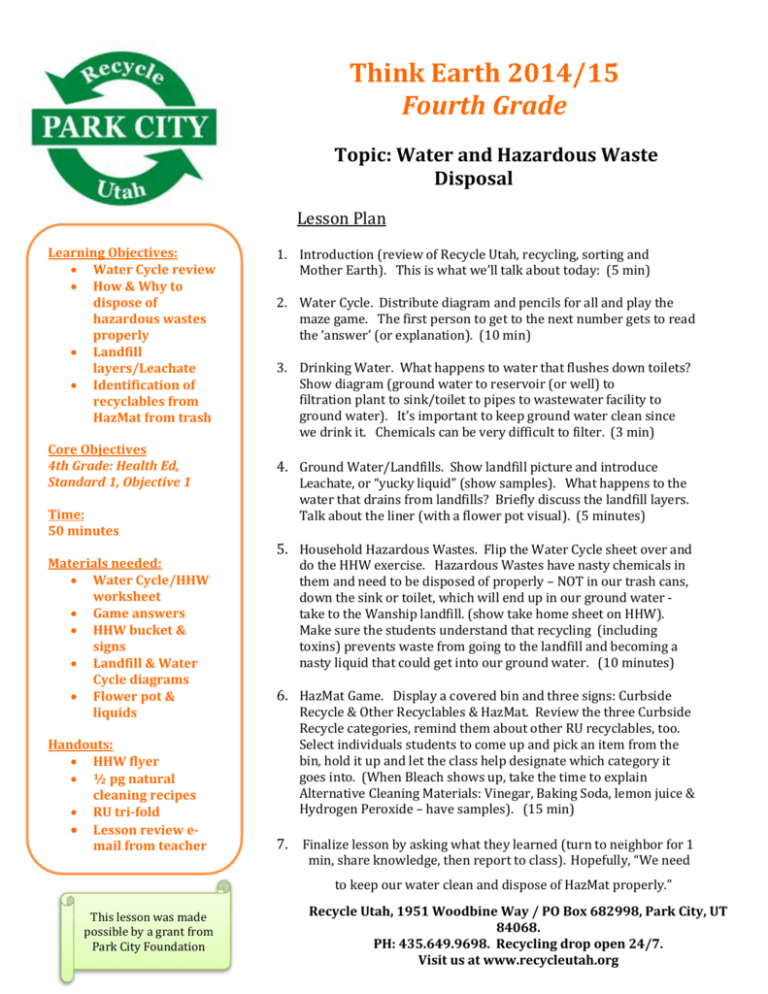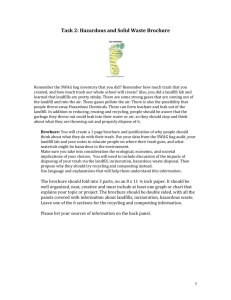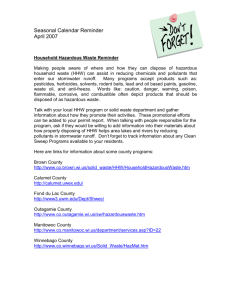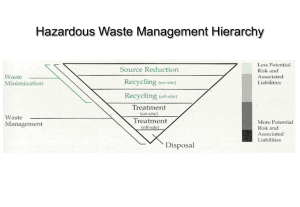Think Earth: Water and Hazardous Waste Disposal
advertisement

Think Earth 2014/15 Fourth Grade Topic: Water and Hazardous Waste Disposal Lesson Plan Learning Objectives: Water Cycle review How & Why to dispose of hazardous wastes properly Landfill layers/Leachate Identification of recyclables from HazMat from trash Core Objectives 4th Grade: Health Ed, Standard 1, Objective 1 Time: 50 minutes Materials needed: Water Cycle/HHW worksheet Game answers HHW bucket & signs Landfill & Water Cycle diagrams Flower pot & liquids Handouts: HHW flyer ½ pg natural cleaning recipes RU tri-fold Lesson review email from teacher 1. Introduction (review of Recycle Utah, recycling, sorting and Mother Earth). This is what we’ll talk about today: (5 min) 2. Water Cycle. Distribute diagram and pencils for all and play the maze game. The first person to get to the next number gets to read the ‘answer’ (or explanation). (10 min) 3. Drinking Water. What happens to water that flushes down toilets? Show diagram (ground water to reservoir (or well) to filtration plant to sink/toilet to pipes to wastewater facility to ground water). It’s important to keep ground water clean since we drink it. Chemicals can be very difficult to filter. (3 min) 4. Ground Water/Landfills. Show landfill picture and introduce Leachate, or “yucky liquid” (show samples). What happens to the water that drains from landfills? Briefly discuss the landfill layers. Talk about the liner (with a flower pot visual). (5 minutes) 5. Household Hazardous Wastes. Flip the Water Cycle sheet over and do the HHW exercise. Hazardous Wastes have nasty chemicals in them and need to be disposed of properly – NOT in our trash cans, down the sink or toilet, which will end up in our ground water take to the Wanship landfill. (show take home sheet on HHW). Make sure the students understand that recycling (including toxins) prevents waste from going to the landfill and becoming a nasty liquid that could get into our ground water. (10 minutes) 6. HazMat Game. Display a covered bin and three signs: Curbside Recycle & Other Recyclables & HazMat. Review the three Curbside Recycle categories, remind them about other RU recyclables, too. Select individuals students to come up and pick an item from the bin, hold it up and let the class help designate which category it goes into. (When Bleach shows up, take the time to explain Alternative Cleaning Materials: Vinegar, Baking Soda, lemon juice & Hydrogen Peroxide – have samples). (15 min) 7. Finalize lesson by asking what they learned (turn to neighbor for 1 min, share knowledge, then report to class). Hopefully, “We need to keep our water clean and dispose of HazMat properly.” This lesson was made possible by a grant from Park City Foundation Recycle Utah, 1951 Woodbine Way / PO Box 682998, Park City, UT 84068. PH: 435.649.9698. Recycling drop open 24/7. Visit us at www.recycleutah.org Supporting Information: LEACHATE is any liquid that in passing through matter, extracts solutes, suspended solids or any other component of the material through which it has passed. Leachate is a widely used term in the environmental sciences where it has the specific meaning of a liquid that has dissolved or entrained environmentally harmful substances which may then enter the environment. It is most commonly used in the context of land-filling of putrescible or industrial waste. In the narrow environmental context leachate is therefore any liquid material that drains from land or stockpiled material and contains significantly elevated concentrations of undesirable material derived from the material that it has passed through. MEDICINE DISPOSAL: at all Summit County sheriff offices and police stations 24/7 in a drop box. WHY IS IT BAD FOR HAZARDOUS WASTES TO GET INTO OUR GROUNDWATER? CAN’T IT BE CLEANED AT THE WASTEWATER FACILITY? What is Ground Water? Ground water is the water present underground in the tiny spaces in rocks and soil. Underground areas where ground water accumulates in large amounts are called aquifers. Aquifers are layers of rock or soil that can store and supply enough water to wells and springs to be economically useful. Most ground water moves slowly--usually no more than a few feet a day. Ground water in aquifers will eventually discharge to or be replenished by springs, rivers, wells, precipitation, lakes, wetlands, and the oceans as part of the Earth's water cycle. Who Uses Ground Water? Ground water accounts for over 95 percent of the nation's available fresh water resources, and is the drinking water source for half the people in this country. Many households, towns, cities, farms, and industries use ground water every day, or depend on lakes and rivers that receive part of their water supplies from ground water. Ground water wells near Superfund sites supply public and private drinking water wells, irrigation, and other agricultural needs, and commercial and industrial businesses. Ground water quality is very important. What is Hazardous Waste? More than 70,000 chemicals are used regularly around the world. Improper use and disposal can have harmful effects on humans, plants, and animals. But even when used properly, many chemicals still have the potential to harm human health and the environment. When these hazardous substances are thrown away, they can become hazardous waste. Hazardous wastes are most often a by-product of a manufacturing process, but there are many sources, including wastes we throw away at home. Regardless of the source, unless we dispose of hazardous waste properly, it can create health risks for people and damage the environment. When hazardous waste is released into the air, water, or on the land it can spread, contaminating a broad area and exposing more people to health risks. Proper management and control can greatly reduce the dangers of hazardous waste. Improper management and disposal of hazardous waste in the past created the hazardous waste sites that are now in the Superfund program. water contamination is nearly always the result of human activity. In areas where population density is high and human use of the land is intensive, ground water is especially vulnerable. Virtually any activity whereby chemicals or wastes may be released to the environment, either intentionally or accidentally, has the potential to pollute ground water. When ground water becomes contaminated, it is difficult and expensive to clean up. Ground Bottom Liner System A landfill's major purpose and one of its biggest challenges is to contain the trash so that the trash doesn't cause problems in the environment. The bottom liner prevents the trash from coming in contact with the outside soil, particularly the groundwater. In MSW landfills, the liner is usually some type of durable, punctureresistant synthetic plastic (polyethylene, high-density polyethylene, polyvinylchloride). It is usually 30-100 mils thick. The plastic liner may be also combined with compacted clay soils as an additional liner. The plastic liner may also be surrounded on either side by a fabric mat (geotextile mat) that will help to keep the plastic liner from tearing or puncturing from the nearby rock and gravel layers. A water molecule is called "H2O" It's made of 2 hydrogen atoms (H + H) and one oxygen atom (O). H2O can be a VAPOR (a gas in the air), a LIQUID (what we usually think of as water or a SOLID (ice).ll The sun is the "pump" that keeps water going around and around. To learn more, find H2O's path through the water cycle, starting in the center at number 1. When you get to each stage in the cycle, read its numbered explanation at the bottom of the page. • Water vapor gathers in clouds. Wind cools the vapor, turning it into a liquid (rain) or solid (snow, hail or sleet). • Gravity makes the water fall to earth. • Some water runs across the land into bodies of surface water -- lakes, streams, oceans, etc. • Other water soaks ("percolates") into the ground. • Percolated water is stored in the ground in "aquifers" (layers of rock, gravel and sand). This ground water slowly moves through the aquifer toward the sea. • Eventually, ground water becomes surface water, too. For example, it may bubble up through the ocean floor, or appear on the land as a spring. • The sun heats surface water, turning it into vapor that rises into the sky. And the cycle begins again!











